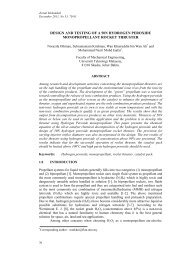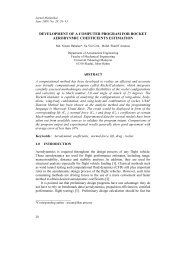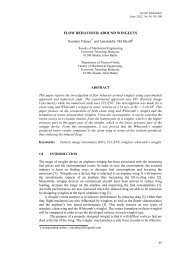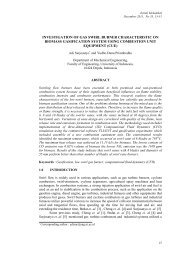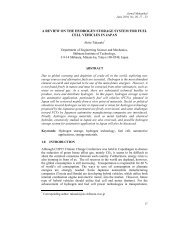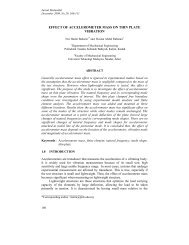structural performance analysis of formula sae car - Jurnal Mekanikal
structural performance analysis of formula sae car - Jurnal Mekanikal
structural performance analysis of formula sae car - Jurnal Mekanikal
You also want an ePaper? Increase the reach of your titles
YUMPU automatically turns print PDFs into web optimized ePapers that Google loves.
5.0 SOLID MODELLING<br />
<strong>Jurnal</strong> <strong>Mekanikal</strong>, December 2010<br />
After load approximation and material selection, preparing CAD model <strong>of</strong> chassis was a<br />
next step. Based on past design knowledge, anthropometric data <strong>of</strong> tallest driver was<br />
taken and previous 3-D chassis model was modified. CATIA V5 s<strong>of</strong>tware tool was used<br />
for designing as well as Finite Element analyses (FEA). SAE rules were taken <strong>car</strong>e <strong>of</strong><br />
while designing. Mankin was created in same s<strong>of</strong>tware on the basis <strong>of</strong> anthropometric<br />
data and checked it under different realistic conditions to suit chassis design. It was a two<br />
way process as firstly creating model and checking clashes with mankin and vice versa<br />
was a repetitive task. After much iteration, CAD model was proposed as shown in Figure<br />
7.<br />
Figure 7: 3D Chassis Structure<br />
Whole <strong>of</strong> the chassis model was made up <strong>of</strong> round hollow cross section tubes <strong>of</strong><br />
IS 3074 steel throughout chassis. Tubes <strong>of</strong> two different sizes were used in the design.<br />
Whole <strong>of</strong> the structure comprises <strong>of</strong> tube 1” (outer diameter) and 1.6 mm wall thickness<br />
except main hoop and front hoop. Both (front and main) hoops are made up <strong>of</strong> 1” (Outer<br />
diameter) and 2.5 mm wall thickness as shown in red color in Figure 7. Mass properties<br />
showed the mass <strong>of</strong> chassis was to be 32 kg.<br />
6.0 FINITE ELEMENT ANALYSIS (FEA)<br />
Structure designing was followed by its testing and consequent validity. To determine the<br />
stiffness <strong>of</strong> a proposed frame design before construction, finite element <strong>analysis</strong> could<br />
serve the purpose. While the process <strong>of</strong> solving Finite Element problems is a science,<br />
creating the models is quite an art [2].<br />
Conventionally in FEA, the frame is subdivided into elements. Nodes are placed<br />
where tubes <strong>of</strong> frame join. There are many types <strong>of</strong> elements possible for a structure and<br />
every choice the analyst makes can affect the results. The number, orientation and size <strong>of</strong><br />
elements as well as loads and boundary conditions are all critical to obtain meaningful<br />
values <strong>of</strong> chassis stiffness [2]. Beam elements are normally used to represent tubes. The<br />
assumption made in using beam elements is that the welded tubes have stiffness in<br />
bending and torsion [2]. If a truss or link elements were used, the assumption being made<br />
would be that the connections do not <strong>of</strong>fer substantial resistance to bending or torsion [2].<br />
Another aspect <strong>of</strong> beam elements is the possibility <strong>of</strong> including transverse shearing<br />
effects.<br />
51



